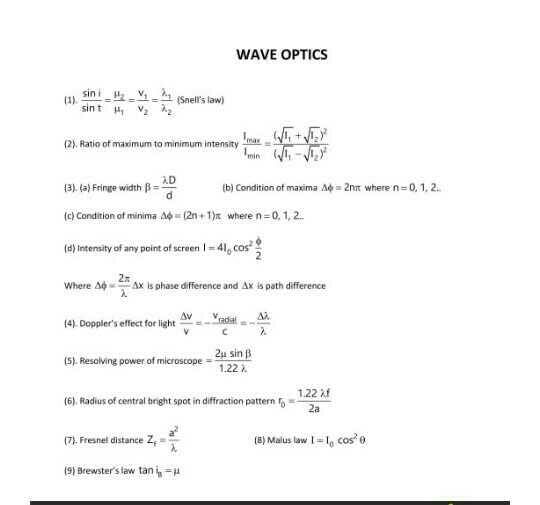NEET Exam > NEET Questions > Important formulas of wave optics
Start Learning for Free
Important formulas of wave optics
Most Upvoted Answer
Important formulas of wave optics
Important Formulas of Wave Optics
1. Wave Equation
The wave equation is given by:
$$\frac{\partial^2 \psi}{\partial x^2} + \frac{\partial^2 \psi}{\partial y^2} + \frac{\partial^2 \psi}{\partial z^2} = \frac{1}{v^2} \frac{\partial^2 \psi}{\partial t^2}$$
where $\psi$ is the wave function, $v$ is the velocity of the wave and $x$, $y$, $z$ and $t$ are the spatial and temporal coordinates respectively.
2. Huygens Principle
The Huygens principle states that every point on a wavefront can be considered as a source of secondary spherical wavelets. These secondary wavelets combine to form the new wavefront.
3. Snell's Law
Snell's law relates the angle of incidence and the angle of refraction of a wave passing through a boundary between two media with different refractive indices. The law is given by:
$$\frac{\sin \theta_1}{\sin \theta_2} = \frac{v_1}{v_2} = \frac{n_2}{n_1}$$
where $\theta_1$ and $\theta_2$ are the angles of incidence and refraction respectively, $v_1$ and $v_2$ are the velocities of the wave in the two media and $n_1$ and $n_2$ are the refractive indices of the two media.
4. Diffraction Grating Equation
The diffraction grating equation relates the angle of diffraction of a wave passing through a diffraction grating to the wavelength of the wave and the spacing between the grating lines. The equation is given by:
$$n \lambda = d \sin \theta$$
where $n$ is the order of diffraction, $\lambda$ is the wavelength of the wave, $d$ is the spacing between the grating lines and $\theta$ is the angle of diffraction.
5. Young's Double Slit Experiment
Young's double slit experiment demonstrates the interference of light waves. The distance between the slits is $d$, the distance between the slits and the screen is $D$ and the wavelength of the light is $\lambda$. The equation for the location of the bright fringes is given by:
$$\tan \theta = \frac{m \lambda}{d}$$
where $m$ is the order of the bright fringe.
Attention NEET Students!
To make sure you are not studying endlessly, EduRev has designed NEET study material, with Structured Courses, Videos, & Test Series. Plus get personalized analysis, doubt solving and improvement plans to achieve a great score in NEET.

|
Explore Courses for NEET exam
|

|
Similar NEET Doubts
Important formulas of wave optics
Question Description
Important formulas of wave optics for NEET 2024 is part of NEET preparation. The Question and answers have been prepared according to the NEET exam syllabus. Information about Important formulas of wave optics covers all topics & solutions for NEET 2024 Exam. Find important definitions, questions, meanings, examples, exercises and tests below for Important formulas of wave optics.
Important formulas of wave optics for NEET 2024 is part of NEET preparation. The Question and answers have been prepared according to the NEET exam syllabus. Information about Important formulas of wave optics covers all topics & solutions for NEET 2024 Exam. Find important definitions, questions, meanings, examples, exercises and tests below for Important formulas of wave optics.
Solutions for Important formulas of wave optics in English & in Hindi are available as part of our courses for NEET.
Download more important topics, notes, lectures and mock test series for NEET Exam by signing up for free.
Here you can find the meaning of Important formulas of wave optics defined & explained in the simplest way possible. Besides giving the explanation of
Important formulas of wave optics, a detailed solution for Important formulas of wave optics has been provided alongside types of Important formulas of wave optics theory, EduRev gives you an
ample number of questions to practice Important formulas of wave optics tests, examples and also practice NEET tests.

|
Explore Courses for NEET exam
|

|
Suggested Free Tests
Signup for Free!
Signup to see your scores go up within 7 days! Learn & Practice with 1000+ FREE Notes, Videos & Tests.


























